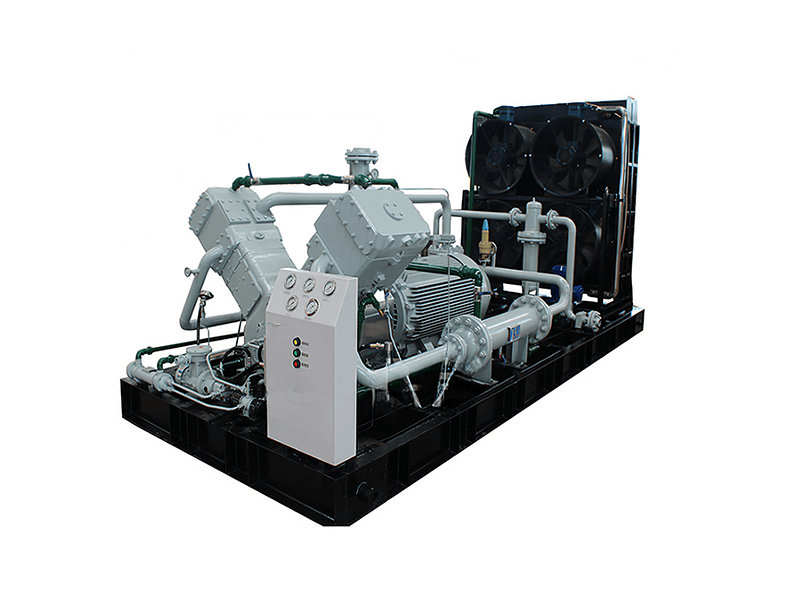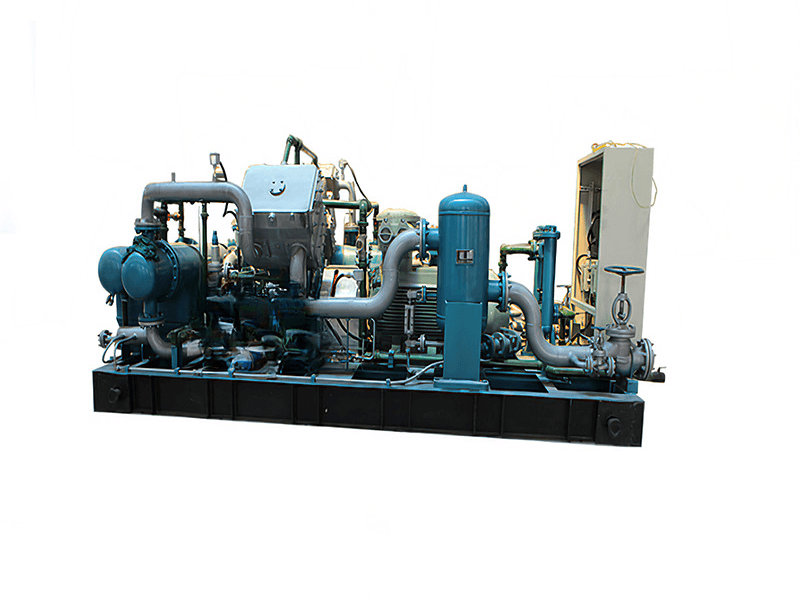Different gases may have specific characteristics and requirements that need to be considered when selecting or designing compressors. Here are some technical requirements for compressors used with different gases:
1. Natural Gas:
- High Compression Ratios: Natural gas compressors are often required to achieve high compression ratios to increase the gas pressure for transportation, storage, or processing.
- Gas Contaminant Handling: Natural gas may contain impurities such as water vapor, hydrogen sulfide, or particulate matter. Compressors for natural gas applications may need to incorporate filtration or separation systems to handle these contaminants and maintain gas purity.
- Compliance with Natural Gas Standards: Compressors used with natural gas must meet industry standards and regulations, such as those set by organizations like the American Petroleum Institute (API) or the International Organization for Standardization (ISO).
2. Hydrogen:
- High Purity Requirements: Compressors for hydrogen applications must be designed to maintain the high purity of hydrogen gas, preventing contamination that could impact safety or the performance of hydrogen-based systems.
- Compatibility with Hydrogen Embrittlement: Hydrogen can cause embrittlement in some materials, so compressors used with hydrogen often require materials that are resistant to hydrogen embrittlement, such as specific alloys or coatings.
- Leak Prevention: Given the small molecular size of hydrogen, compressors for hydrogen applications must be designed with tight seals and leak prevention measures to minimize hydrogen loss and ensure safe operation.
3. Oxygen:
- Oil-Free and Contamination-Free Compression: Compressors used with oxygen must provide oil-free and contamination-free compression to maintain the purity and safety of the compressed oxygen.
- Compatibility with Oxygen Enriched Atmospheres: Compressors for oxygen applications may require special materials and coatings to ensure compatibility with oxygen-enriched atmospheres and prevent ignition or combustion risks.
4. Carbon Dioxide (CO2):
- High-Pressure Capabilities: Compressors for carbon dioxide applications may need to handle high pressures, particularly in carbon capture and storage (CCS) or enhanced oil recovery (EOR) processes where CO2 is compressed for injection into underground formations.
- Gas-Liquid Separation: Carbon dioxide can exist in both gas and liquid phases, and compressors used with CO2 may require integrated gas-liquid separation systems to separate and remove liquid CO2 from the compressed gas stream.
5. Refrigerant Gases:
- Compatibility with Specific Refrigerants: Compressors used in refrigeration and air conditioning applications must be compatible with the specific refrigerant gases being used, such as R-134a, R-410A, or R-22.
- Lubrication Requirements: Some refrigerant gases require specific lubricants to ensure proper compressor operation and minimize wear. Compressors used with refrigerants must be designed to accommodate the appropriate lubrication requirements of the specific refrigerant being utilized.
6. Specialty Gases:
- Gas-Specific Compatibility: Compressors used with specialty gases, such as helium, argon, or nitrogen, may need to be designed or selected based on the specific compatibility requirements of those gases, including their chemical properties, pressures, and temperature ranges.
- Gas Purity and Contaminant Handling: Specialty gases often require high purity levels, and compressors used with such gases must incorporate filtration and purification systems to remove impurities and maintain gas purity.
7. Ammonia:
- Corrosion Resistance: Compressors used with ammonia should be constructed with materials that are resistant to the corrosive nature of ammonia, such as stainless steel or other compatible alloys.
- Leak Detection and Safety Measures: Ammonia is toxic and flammable, so compressors for ammonia applications may incorporate leak detection systems and safety measures to ensure prompt detection and mitigation of leaks.
- Efficient Heat Dissipation: Ammonia compressors may require efficient heat dissipation mechanisms to manage the heat generated during compression and maintain optimal operating temperatures.

8. Chlorine:
- Chemical Compatibility: Compressors used with chlorine must be constructed with materials that are chemically compatible with chlorine and can withstand its corrosive properties.
- Leak Prevention and Safety Features: Given the hazardous nature of chlorine gas, compressors used with chlorine should incorporate robust leak prevention systems and safety features to ensure the containment and safe handling of the gas.
- Ventilation and Exhaust Systems: Chlorine compressors may require dedicated ventilation and exhaust systems to control and remove any residual chlorine gas or fumes during operation.
9. Sulfur Dioxide (SO2):
- Corrosion Resistance: Compressors used with sulfur dioxide should be designed with materials that are resistant to corrosion caused by the presence of SO2 gas.
- Gas-Liquid Separation: Sulfur dioxide can exist in both gas and liquid phases, and compressors handling SO2 may require gas-liquid separation systems to remove liquid droplets and ensure efficient compression of the gas.
- Efficient Compression at Low Temperatures: Sulfur dioxide is typically compressed at low temperatures, so compressors used with SO2 should be capable of efficient operation under these conditions.
10. Nitrous Oxide (N2O):
- Purity Maintenance: Compressors used with nitrous oxide must ensure the maintenance of gas purity to avoid contamination and maintain the quality of the compressed N2O.
- Thermal Management: Nitrous oxide compression can generate significant heat, so compressors for N2O applications may require effective thermal management systems to prevent overheating and ensure safe operation.
- Compatibility with N2O Properties: Nitrous oxide has unique properties, such as its high density and low critical temperature. Compressors used with N2O should be designed to accommodate these properties for efficient compression.
11. Propane:
- High-Pressure Capabilities: Compressors used with propane may need to handle high pressures, particularly in industrial applications or propane storage and distribution systems.
- Spark-Free Operation: Propane is highly flammable, so compressors used with propane should be designed for spark-free operation and incorporate safety measures to prevent ignition or combustion risks.
- Lubrication and Oil Separation: Propane compressors may require specialized lubrication and oil separation systems to prevent oil carryover and maintain the purity of the compressed propane gas.
12. Acetylene:
- Dissolved Acetylene Compression: Acetylene is often compressed and stored in a dissolved state in a suitable solvent. Compressors used with acetylene should be designed specifically for the compression of acetylene dissolved in the solvent.
- Safety Features: Acetylene is highly unstable and can be explosive under certain conditions. Compressors for acetylene applications require robust safety features and adherence to strict safety guidelines to ensure secure containment and handling of the gas.
13. Methane:
- High-Efficiency Compression: Compressors used with methane should be designed for efficient compression to minimize energy consumption and optimize the overall system performance.
- Gas Leakage Prevention: Methane is a potent greenhouse gas, so compressors for methane applications should incorporate effective sealing mechanisms and leak detection systems to prevent gas leakage and minimize environmental impact.
- Safety Measures: Methane is highly flammable, and compressors used with methane should be equipped with safety features such as explosion-proof designs, gas detection systems, and emergency shutdown mechanisms.
14. Ethylene:
- Low Temperature Operation: Ethylene is often transported and stored at cryogenic temperatures. Compressors used with ethylene must be designed to handle low-temperature operation and maintain the required temperature conditions for the gas.
- Materials Compatibility: Ethylene can cause embrittlement in certain materials, so compressors for ethylene applications may require materials that are resistant to ethylene embrittlement and can withstand the low-temperature conditions.
- Leakage Control: Ethylene is a flammable gas, and compressors used with ethylene should incorporate effective sealing mechanisms and leak prevention systems to ensure safe containment and minimize the risk of leaks.
15. Argon:
- High Purity Compression: Argon is often used in applications that require high gas purity. Compressors used with argon should maintain the purity of the gas and minimize contamination during compression.
- Compatibility with Inert Gases: Argon is an inert gas, and compressors used with argon should be designed to handle the unique characteristics of inert gases, such as low reactivity and high thermal conductivity.
- High-Pressure Capabilities: Compressors for argon applications may need to handle high-pressure requirements, particularly in industrial processes or applications that involve pressurized argon gas.
16. Hydrocarbon Gases:
- Oil-Free Compression: Compressors used with hydrocarbon gases, such as butane or propane, should provide oil-free compression to maintain the purity of the gas and prevent contamination.
- Spark-Free Operation: Hydrocarbon gases are highly flammable, and compressors used with these gases should be designed for spark-free operation and incorporate safety measures to prevent ignition or combustion risks.
- Corrosion Resistance: Hydrocarbon gases can be corrosive to certain materials, and compressors used with hydrocarbon gases should be constructed with corrosion-resistant materials to ensure long-term durability.
17. Helium:
- High Efficiency at Low Pressures: Helium is often compressed at low pressures. Compressors used with helium should be designed for efficient operation at these lower pressure ranges.
- Gas Recovery and Recirculation: Helium is a valuable and finite resource. Compressors used in helium applications may incorporate gas recovery and recirculation systems to minimize helium loss and improve overall efficiency.
- Compatibility with Helium Properties: Helium has unique properties, such as low density and high thermal conductivity. Compressors used with helium should be designed to accommodate these properties for optimal performance.
18. Hydrogen Sulfide (H2S):
- Corrosion Resistance: Hydrogen sulfide is highly corrosive, and compressors used with H2S should be constructed with materials that are resistant to corrosion caused by the presence of H2S gas.
- Safety Measures: Hydrogen sulfide is toxic and poses health hazards. Compressors for H2S applications should incorporate safety features, such as gas detection systems and proper ventilation, to ensure worker safety and prevent exposure to H2S gas.
- Gas Purification: Compressors used with hydrogen sulfide may require integrated gas purification systems to remove impurities and maintain the purity of the compressed gas.
19. Carbon Monoxide (CO):
- Compatibility with High Temperatures: Carbon monoxide is often generated at high temperatures. Compressors used with CO should be designed to handle the elevated temperatures and maintain proper operation under such conditions.
- Safety Measures: Carbon monoxide is a toxic gas. Compressors for CO applications should incorporate safety features, such as gas detection systems and proper ventilation, to prevent human exposure to CO gas.
- Gas Purification: Compressors used with carbon monoxide may require purification systems to remove impurities and ensure the purity of the compressed gas.
20. Specialty Gases with Unique Requirements:
- Some specialty gases, such as noble gases (e.g., neon, xenon), calibration gases, or process gases used in specific industries, may have unique technical requirements for compressors. These requirements can vary widely based on the specific gas properties, desired purity levels, pressure ranges, and safety considerations.
- It is crucial to consult gas manufacturers, industry standards, and compressor manufacturers to obtain detailed guidelines and specifications for compressors used with these specialty gases.
These examples further emphasize the technical requirements for compressors used with different gases. It's essential to consider the specific characteristics, properties, and safety considerations associated with each gas to ensure the appropriate selection or design of compressors. Consulting experts, industry guidelines, and equipment manufacturers will provide valuable insights and recommendations for meeting the technical requirements of compressors used with different gases.

























